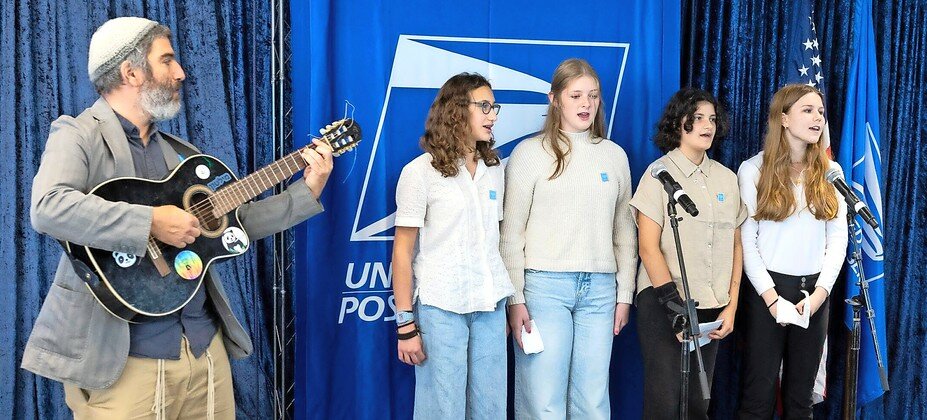At post office, Chanukah comes early this year
Chanukah came 13-and-a-half weeks early at the Capital Jewish Museum in Washington, as a band and a Jewish student choir performed songs about dreidels and menorahs, as well as Yiddish and Ladino music.
Beatrice Gurwitz, the museum’s incoming executive director, thanked the musicians for helping the audience, of about 75, get into the holiday spirit during the United States Postal Service’s first-day-of-issue event on Thursday for its new Chanukah stamp.
“I’m very honored. Of course, I really wish some of my family were still around to see it,” the stamp’s designer, Antonio Alcalá, who is Jewish, told JNS. “The stamp began 86 years ago with Kristallnacht.”
The designer’s grandparents sent his mother and her siblings on the Kindertransport out of Hamburg, Germany. His mother ended up in America, and Alcalá grew up in San Diego. The decision his grandparents made led to Alcalá being able to design the Chanukah stamp, which is poised to reach millions, he said.
“It was very satisfying,” he said. He has worked previously on stamps about historical figures. “This becomes a bit more personal,” he said.
Alcalá said didn’t need to rely as much on consultants, as he did in the past to provide context about stamp projects. “I kept having flashbacks to going to my grandparents’ house.”
Technically, Jews light a nine-branched chanukiah on Chanukah, and menorah refers to the seven-branched candelabrum in the Temples, but the word menorah is often used for the former as well.
His family chanukiah had candles and “was not overly ornamental,” he recalled. “It had a certain decorative element, but it was not fancy and it was not modern.”
The menorah he designed for the Chanukah stamp — which the Postal Service has released every few years since 1996 — lacks a base, suggesting it wouldn’t stand freely. It has thin, curved arms, but Alcalá took pains to vary the weight of the lines, eschewing symmetry.
“It feels, to me, a little bit humble in a way. It’s not highly polished or refined. It feels direct,” he said. “When I reached that, I felt like this was starting to reflect more of the attitude that I was hoping would be conveyed.”
Alcalá left candles out of his design — to suggest the role of faith in that gap between fire and menorah, he told JNS — and he arrived at the final design after first working on the computer, but setting that aside and painting in black and white after the design on the screen “felt a little cold and impersonal.”
The Postal Service plans to print 10 million stamps with his new design, suggesting it’s likely to join some of the other best-known menorahs, including on the Arch of Titus in the Roman Forum and on the Emblem of Israel and outside the Knesset in Jerusalem.
“It’s a crazy thing to think that this will be everywhere in the country. Every post office will have at least one sheet of the stamp from Bangor, Maine, to Texas and Alaska,” he told JNS.
Alcalá designed the new Chanukah stamp in 2021, before Oct. 7. If he were designing it today, “I’m sure it would be different,” he said.
Michael Gordon, the government liaison director at the Postal Service who was also on hand at the event, told JNS that ‘generally speaking, current events don’t get reflected in stamps. We want it to be a positive, unifying message.”
Like Alcalá, Gordon, who is Jewish, reflected on Chanukah memories as a child. “It tends to be more of a kids’ holiday,” he said.
Every year, Ezra Academy in Woodbridge, Conn., hosts a big Chanukah production, and Gordon told JNS that the event — a “cute little kindergarten thing” — in which one kid would be the Shamash and others would be other candles, made a lasting impression on him and his siblings.
“I can still remember some of the songs that we sang,” he said. “It was the only time, really, that all of the families got together.” The Chanukah celebration became “an indelible memory” for him, even though, he added, “I don’t remember a whole lot of things that happened yesterday.”
“A stamp can be a unifying message,” he said. “It’s the same stamp. It can travel from Alaska to the US Virgin Islands, or Maine to Guam. Much like Chanukah, it can be a family, unifying event.”
Brig. Gen. (ret.) Mitchell “Mick” Zais, former president of the American Philatelic Society, came to the ceremony from South Carolina, where he is a former state superintendent of education and former president of Newberry College.
Zais, who has been to about 25 first-day-of-issue stamp ceremonies, is also a former deputy US secretary of education and a former acting education secretary.
He told JNS that his late father, Gen. Melvin Zais, a former NATO commander, was the only Jewish four star general in US history.









